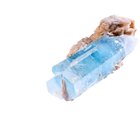White jade is one of two varieties of common jade, the other being green. Both are popular in Asian history, art and folklore, as well as being featured in the ancient cultures of Central and South America. In Chinese culture, white jade was prized above gold. This value had much to do with the symbolism and meaning behind jade itself.
History
The oldest dynasties of China considered jade to be the blood of Pan Gu, the Creator God of the universe. This blood came in levels of purity, with white jade being the most highly prized. It was instantly considered a divine gemstone with certain inherent magical properties. White jade was championed by the ancient scholar Xu Shen, who considered it to be a stone of five virtues, based on its color and property: purity, kindness, rectitude, wisdom and bravery.
The He Shi Bi
White jade was used to make the famous Imperial Seal of China, called the He Shi Bi or Heirloom Seal. It was used to denote royal right to rule, the physical representation of the so-called Mandate of Heaven. This artifact was carved from a large chunk of white jade and emblazoned with calligraphy. Eventually lost to history, the iconography of white jade went on to inspire other royal seals, similar to the West's motif for purple being a royal color.
Immortality
Jade of both white and green was considered, owing to its supposed divine origin, a potential source of immortality. The First Emperor of a unified China, Ch'in Shi Huangdi, is reported to have been buried in a full bodysuit of jade in the hopes that the jade's power would regenerate him. This became a popular practice among Chinese nobles, and many bodies were interred with similar jade regalia.
Jade cabbage
White jade is commonly carved into living images, such as plants or animals. Some of the most popular white jade sculptures are of cabbage, which symbolizes wealth (dating back to wealth being associated with good harvests and bountiful crops.) Other white jade items are of sacred animals, rendering the likenesses of "divine" animals with the loftiest variety of the most prized gemstone of Asia. As a result, many white jade sculptures are meant to confer luck and fortune upon the owner.
White jade dragons
As with green jade, white jade is often used to sculpt dragon images. The dragon is a symbol of wisdom, ferocity, fortune and royalty, and any sculpture embodies these varied meanings as well. White jade dragon emblems have been found in royal tombs in Japan, Korea and China, with some dating back to the earliest Chinese dynasties of five thousand years ago.
Related Articles

Difference Between Manmade & Natural ...

List of the Types of Semi-Precious ...

Types of Valuable Crystals

The Meaning of a White Orchid

How to Make a Swan Lake Headpiece

What Is a Pink Amethyst?

What Is White Buffalo Turquoise?

What Are the Family Ties for the Greek ...

Physical Characteristics of the Ruby ...

Metal Types for Rings Similar to ...

The History of Hair Dye Colors

What Do Frog Tattoos Mean?

Chinese Wedding Anniversary Gifts

Names of Different Red Shades

Hawaiian Traditional Gifts

What Is Marcasite Jewelry?

What Does a Purple Iris Symbolize?

Korean Food Nutritional Value

Can a White Gold Ring Be Made into ...

What Is 916 in Jewelry?